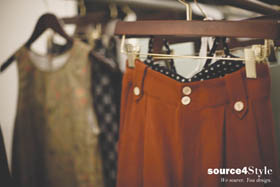My love for the environment drives my passion for fashion. When it comes to what we wear, we seldom consider how it affects the natural, cultural, and economic world around us. But both designers and consumers are becoming increasingly aware of the socio-environmental footprint caused by the clothing we produce and wear. More than ever, people want to style themselves naturally, but they’re finding it difficult to do so.
Ask any fashion designer to identify the most challenging part of their job, and the answer will undoubtedly be “sourcing.” Sourcing, or the pursuit and purchase of the materials and services needed to complete a design, is timeconsuming and in need of systems and technology to streamline the process.
According to research undertaken by Source4Style over the past few years, designers source up to five times a year and can spend more than 75 percent of their total time sourcing for their collections. Because search costs are high compared to other necessary tasks like design and sales, this erodes valuable time needed to market the products to their intended customers, which compromises the success of the entire brand.
The challenge of sourcing becomes much greater when designers seek to source from environmentally friendly materials. Small-scale suppliers around the globe who produce green materials lack the channels necessary to reach international buyers. This lack of market access becomes more apparent at a time when an increasing number of designers are looking to use such materials.
The idea for Source4Style emerged in the fall of 2009 based on initial research indicating that the barriers to sourcing, particularly eco-friendly sourcing, are extremely challenging for designers. On the other end of the supply chain, suppliers lack the potential benefit from having a user-friendly marketplace that showcases and sells their offerings more effectively.
Source4Style is designed to be the business-to-business (B2B) online marketplace that allows designers and brands to search and source more eco-friendly materials and services from a network of global suppliers. The marketplace opens up the inventory of materials—and eventually services—resulting in a 365-day-a-year online tradeshow, whereby a designer can review materials, compare prices of similar product offerings, order a swatch, book an order, or connect with a supplier through insite messaging.
Source4Style collects up to 245 data points of technical, social, cultural, and environmental information for each specific material in order to capture a more robust snapshot of the fabric. Many of the environmental-related criteria are based on the Eco Index—the widely accepted environmental assessment tool for the apparel industry. This collection of baseline data creates a more transparent supply chain at the material level so designers can source based on the criteria that meets their design principles and the principles of their consumers.
Sourcing in this way requires a subtle shift in mindset. Designers are not used to sourcing materials directly online. In some cases, independent designers—who generally spend anywhere from $5,000– $100,000 on materials every year—are unaccustomed to buying directly from the supplier (versus buying from a wholesaler). Source4Style gives the buyer the critical information needed to make the best purchase. The ability to purchase sampling yardage prior to purchasing the material for production allows for greater confidence in the product, without having to ever leave one’s office. Source4Style is both a supplement and an alternative to traditional sourcing via long trips, tradeshows, showrooms, or online directories.
This change in buying patterns, along with new technology to help streamline the sourcing supply chain, creates a marketplace for eco-friendly materials. This will likely lead to crowd-sourcing around green design—the first step in making environmentally conscious design possible on a large scale.
On the horizon for Source4Style include increasingly sophisticated supply chain management tools; calculators to measure not just a sample garment’s carbon footprint but also the footprint of one designer’s specific supply chain; and mapping technology to promote vertical integration in a sector in which a single garment can travel the world before it finds a permanent home in someone’s closet.
Acting as a curator for eco-friendly designs, Source4Style seeks to unveil globally what is produced locally and, in the process, use technology to bridge the divides that exist in the vast world of materials—changing the sourcing landscape and the designs it yields.




